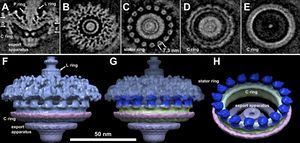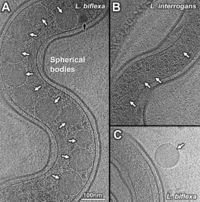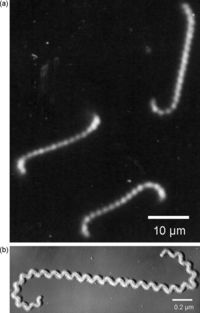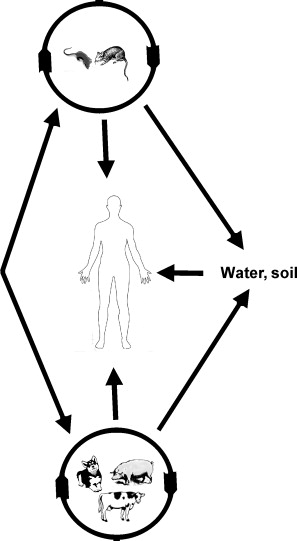Leptospira Species in the Environment: Difference between revisions
From MicrobeWiki, the student-edited microbiology resource
No edit summary |
No edit summary |
||
| Line 1: | Line 1: | ||
==Introduction== | ==Introduction== | ||
[[Image:Leptospira shape.jpg|thumb|200px|right|Figure 1. Dark field (a) and shadowed electron (b) photomicrographs of Leptospira spp.]] | [[Image:Leptospira shape.jpg|thumb|200px|right|Figure 1. Dark field (a) and shadowed electron (b) photomicrographs of Leptospira spp.]] | ||
[[Image:LPS figure.gif|thumb| | |||
[[Image:LPS figure.gif|thumb|400px|right|Figure 2.The outer membrane (Om), inner membrane (IM), peptidoglycan layer (PG), and periplasmic flagellum (PF) in a 3-D reconstruction of intact L. interrogans (A) and L. biflexa (B).Zoom-in views reveal the detail of the cell envelope of L. interrogans (C) and L. biflexa (D). Panels E and F show the density profiles of L. interrogans and L. biflexa, respectively. ]] | |||
<br>By Toni Miller<br> | <br>By Toni Miller<br> | ||
Revision as of 01:10, 23 April 2014
Introduction

Figure 2.The outer membrane (Om), inner membrane (IM), peptidoglycan layer (PG), and periplasmic flagellum (PF) in a 3-D reconstruction of intact L. interrogans (A) and L. biflexa (B).Zoom-in views reveal the detail of the cell envelope of L. interrogans (C) and L. biflexa (D). Panels E and F show the density profiles of L. interrogans and L. biflexa, respectively.
By Toni Miller

Figure 3.Molecular architecture of the intact flagellar motor of Leptospira spp.(A) Centered section parallel to the direction of the filament of an assymetric reconstruction of the Leptospiral motors. Panels B, C, D and E are horizontal cross sections.The locations of the sections are indicated in panel A. Panel B shows a section that lies inside the socket formed by the collar in periplasmic space. Section C transects the cytoplasmic side of the MS ring, just above the C ring. Sections D and E are located on the top and bottom of the C ring, respectively. Surface rendering of the Leptospira flagellar motor is presented in panels F and G.

Figure 4. Two types of spherical bodies in Leptospira spp. High and low density spherical bodies were labeled with dark and white arrows, respectively. (A) Cryo-ET tomogram slice of an L. biflexa cell, with spherical bodies (`100nm) located in the cell center. (B) Cryo-ET of an L. interrogancs cell shows that the spherical bodies are randomly positioned along the cell body, with a diameter of `30 nm. (C) High-magnificatoin view of a spherical body showing the absence of a phospholipid bilayer.
Introduce the topic of your paper. What microorganisms are of interest? Habitat? Applications for medicine and/or environment?
Section 1
Include some current research, with at least one figure showing data.


